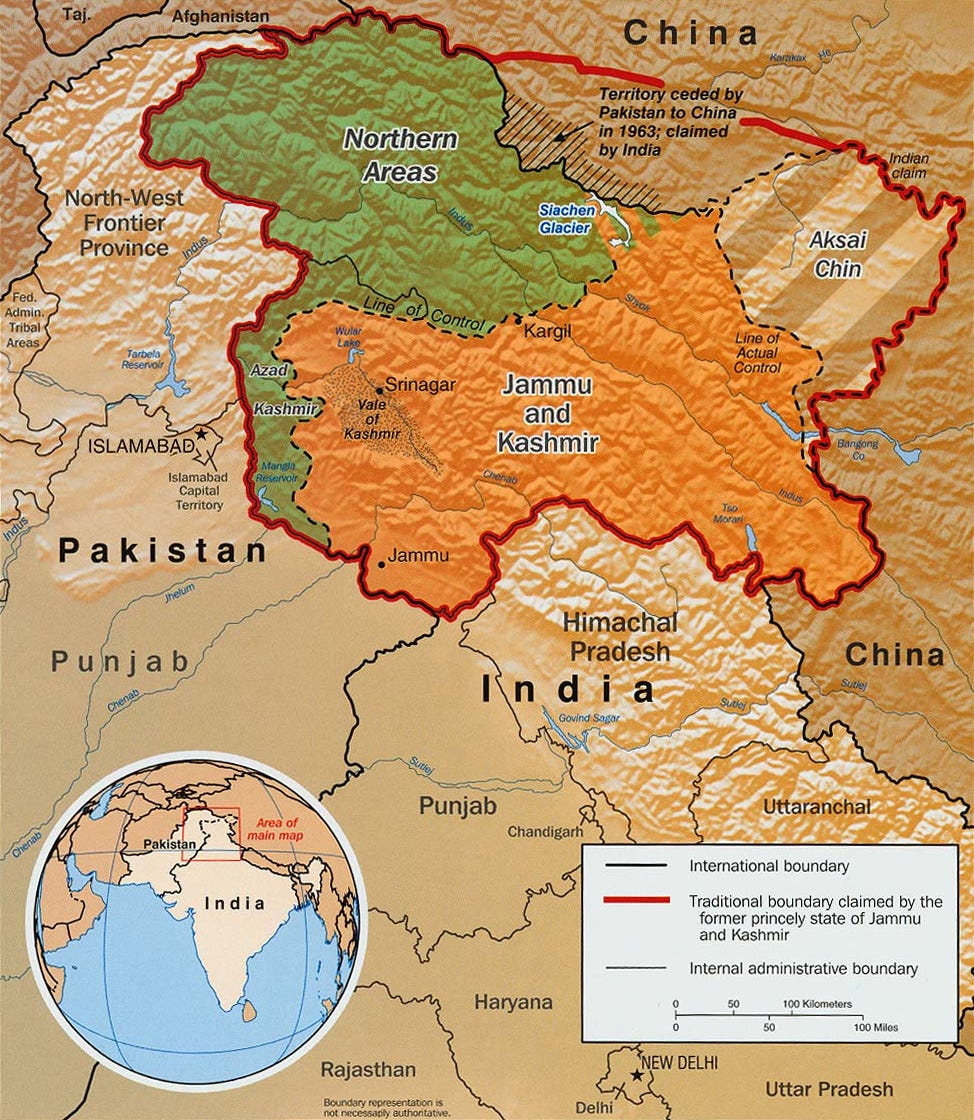The Specter of Nuclear War: Why India-Pakistan Tensions Over Kashmir Remain Dangerous
Srinagar 19 May 2025: The possibility of nuclear conflict between India and Pakistan remains a serious concern, particularly in the context of ongoing tensions in Kashmir. Both nations possess nuclear capabilities, and past conflicts have repeatedly raised fears of escalation.
Historical Context: A Legacy of Conflict
Since Partition in 1947, India and Pakistan have fought multiple wars over Kashmir, with each conflict increasing the stakes. The Kargil War in 1999 was particularly alarming, as it involved direct military engagement between two nuclear-armed states.
Recent Escalations: Rising Tensions Post-Pahalgam Attack
Following the April 22 Pahalgam terror attack, which claimed 26 lives, tensions have risen sharply. India has conducted military strikes on suspected terrorist hideouts in Pakistan-controlled Kashmir, while Pakistan has retaliated with air defenses. The situation has led to increased military mobilization along the Line of Control (LoC).
Nuclear Threats & Strategic Posturing
Pakistan’s leadership has openly hinted at the possibility of using nuclear weapons if the conflict escalates further. However, military experts argue that Pakistan lacks the strategic depth to withstand a nuclear retaliation from India. India, on the other hand, maintains a No First Use (NFU) policy, but has stated that any nuclear attack would be met with a massive response.
International Mediation & Diplomatic Efforts
The United States has stepped in to mediate, with former President Donald Trump offering to help resolve the Kashmir dispute. While Pakistan welcomed the intervention, India has remained firm in its stance that Kashmir is an internal matter.
Global diplomatic responses to tensions between India and Pakistan over Kashmir have been mixed, with world powers urging de-escalation while acknowledging the complexity of the issue.
U.S. & Western Mediation Efforts
The United States has historically played a diplomatic role in India-Pakistan relations. Former President Donald Trump offered mediation on the Kashmir dispute, but India has consistently maintained that Kashmir is an internal matter. Meanwhile, Western nations, including the UK and the EU, have encouraged peaceful resolutions through bilateral talks.
China’s Strategic Position
China, a close ally of Pakistan, has voiced concerns about Kashmir’s security, particularly due to its interest in the China-Pakistan Economic Corridor (CPEC). Beijing has urged restraint but also maintained diplomatic ties with India, balancing its interests on both sides.
United Nations & International Calls for Peace
The United Nations (UN) has frequently called for diplomatic solutions to the Kashmir conflict. While its resolutions regarding Kashmir’s status have been longstanding, both India and Pakistan interpret them differently. Several human rights groups have also raised concerns over the humanitarian impact of prolonged instability in the region.
De-escalation Strategies
Experts suggest that backchannel diplomacy, bilateral agreements, and economic cooperation could help reduce tensions. Some analysts propose confidence-building measures, such as joint peacekeeping efforts or trade partnerships, to foster better relations between the two nuclear-armed nations.
Historical Peace Treaties That Have Shaped India-Pakistan Relations
Over the years, India and Pakistan have signed multiple agreements and treaties aimed at reducing tensions and maintaining stability, particularly over Kashmir. While some agreements have led to periods of peace, others have been overshadowed by renewed conflicts.
The Karachi Agreement (1949)
- Signed under the United Nations Commission for India and Pakistan (UNCIP) after the First Indo-Pak War (1947-1948).
- Established the Ceasefire Line, which later became the Line of Control (LoC) after the Simla Agreement (1972).
- Introduced UN military observers to monitor ceasefire violations, though their role remains limited today.
The Tashkent Agreement (1966)
- Signed after the Second Indo-Pak War (1965) under Soviet mediation.
- Both nations agreed to withdraw forces from occupied territories, returning to pre-war positions.
- Aimed to establish peaceful relations but lacked enforcement mechanisms, leading to future clashes.
The Simla Agreement (1972)
- Signed after the Third Indo-Pak War (1971), which led to the creation of Bangladesh.
- Defined the LoC in Kashmir, emphasizing bilateral resolution of disputes.
- India and Pakistan pledged to respect territorial integrity, but violations have continued over time.
The Indus Waters Treaty (1960)
- A unique treaty solely focused on water-sharing between India and Pakistan, brokered by the World Bank.
- Despite conflicts, both nations have largely adhered to the water-sharing agreement, making it one of the most successful treaties in the region.
The Lahore Declaration (1999)
- A peace initiative signed by then Indian PM Atal Bihari Vajpayee and Pakistan’s Nawaz Sharif.
- Focused on reducing nuclear threats, preventing arms escalation, and fostering dialogue.
- The Kargil War (1999), initiated just months later, severely impacted the spirit of the agreement.
Future Prospects for Peace Agreements
While existing treaties provide a framework for peace, the lack of trust, political volatility, and security concerns hinder their effectiveness. Experts suggest that trade collaborations, diplomatic dialogues, and crisis prevention measures could strengthen India-Pakistan relations in the long run.
Recent Diplomatic Efforts & Expert Opinions on Kashmir’s Stability
India and Pakistan continue to navigate complex diplomatic relations, with Kashmir remaining a central flashpoint. While past treaties and ceasefires have provided temporary relief, tensions persist due to border disputes, militant activities, and political instability.
Recent Diplomatic Moves
- Bilateral Talks on Ceasefire Stability: Since the 2021 India-Pakistan ceasefire agreement, sporadic violations have occurred, but diplomatic channels remain open to prevent escalation.
- Track II Diplomacy: Civil society groups and retired diplomats from both nations have engaged in unofficial dialogues to explore long-term peace strategies.
- Regional Cooperation Efforts: The Shanghai Cooperation Organization (SCO) has attempted to mediate discussions, encouraging both nations to focus on economic cooperation instead of military conflicts.
Expert Opinions on Kashmir’s Future Stability
Security Analysts: Many experts believe that terror activities and border skirmishes remain the biggest threats to long-term stability in Kashmir. Increased counter-terror operations have been effective but have also led to diplomatic friction.
Political Commentators: Some argue that greater autonomy and local governance within Kashmir could help stabilize the region, reducing external tensions. Others insist that only sustained diplomatic engagement between India and Pakistan can prevent future conflicts.
Global Peacemakers: International organizations emphasize that economic development and cultural exchanges could serve as confidence-building measures, fostering improved ties between the two nations.
Future Prospects for De-escalation
With sustained diplomatic efforts, Kashmir has the potential to emerge as a more peaceful and economically strong region. Analysts suggest that trade agreements, cross-border tourism, and cultural collaborations could significantly reduce hostility over time.
Global Economic Partnerships: A Key to Kashmir’s Stability?
Kashmir’s stability is often discussed in political and security terms, but economic partnerships could provide a long-term solution for peace. Strengthening cross-border trade, infrastructure development, and business cooperation could turn Kashmir into a thriving economic hub, benefiting both India and Pakistan.
The Role of Cross-Border Trade
- Reviving India-Pakistan trade routes could provide jobs and economic opportunities for local businesses.
- Increasing exports of handicrafts, tourism services, and agricultural goods could help strengthen Kashmir’s economy.
- Collaborative trade initiatives have historically helped reduce tensions by creating shared economic interests.
Infrastructure Development & Investments
- Investment in transport, energy, and technology could modernize Kashmir, attracting domestic and foreign investments.
- International organizations could facilitate economic growth projects focused on education, small businesses, and healthcare.
- Improved rail and road connectivity between India and Pakistan could bolster regional trade exchanges.
Business & Tourism: A Path to Peace
- Encouraging cross-border business partnerships could increase trust and diplomatic engagement.
- Tourism, a major industry for Kashmir, could flourish with increased travel cooperation.
- Regional tourism initiatives could promote cultural exchanges, reinforcing peaceful coexistence.
Future Prospects & Global Influence
- The United Nations, World Bank, and regional economic groups could support projects that strengthen Kashmir’s economy.
- International trade agreements could incentivize cooperation over conflict, fostering long-term diplomatic ties.
- A stronger Kashmir economy would reduce dependence on external aid, making the region more self-sustaining.
By focusing on economic development, Kashmir could shift away from being a conflict zone and instead become a center for growth and prosperity.
Future Implications: The Risk of Escalation
Despite the current ceasefire, the risk of nuclear escalation remains. Experts warn that any miscalculation or provocation could lead to a catastrophic conflict. The presence of nuclear weapons in both countries means that even conventional warfare carries the risk of unintended escalation.



